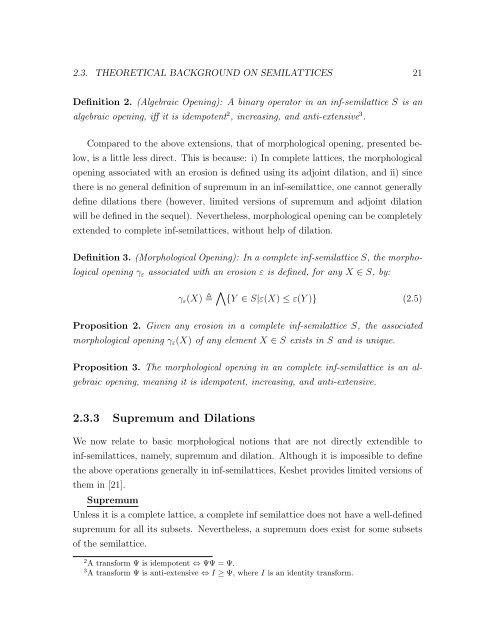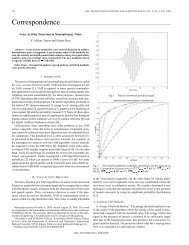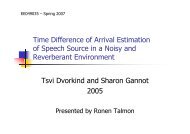Thesis (PDF) - Signal & Image Processing Lab
Thesis (PDF) - Signal & Image Processing Lab
Thesis (PDF) - Signal & Image Processing Lab
Create successful ePaper yourself
Turn your PDF publications into a flip-book with our unique Google optimized e-Paper software.
2.3. THEORETICAL BACKGROUND ON SEMILATTICES 21<br />
Definition 2. (Algebraic Opening): A binary operator in an inf-semilattice S is an<br />
algebraic opening, iff it is idempotent 2 , increasing, and anti-extensive 3 .<br />
Compared to the above extensions, that of morphological opening, presented be-<br />
low, is a little less direct. This is because: i) In complete lattices, the morphological<br />
opening associated with an erosion is defined using its adjoint dilation, and ii) since<br />
there is no general definition of supremum in an inf-semilattice, one cannot generally<br />
define dilations there (however, limited versions of supremum and adjoint dilation<br />
will be defined in the sequel). Nevertheless, morphological opening can be completely<br />
extended to complete inf-semilattices, without help of dilation.<br />
Definition 3. (Morphological Opening): In a complete inf-semilattice S, the morpho-<br />
logical opening γε associated with an erosion ε is defined, for any X ∈ S, by:<br />
γε(X) � � {Y ∈ S|ε(X) ≤ ε(Y )} (2.5)<br />
Proposition 2. Given any erosion in a complete inf-semilattice S, the associated<br />
morphological opening γε(X) of any element X ∈ S exists in S and is unique.<br />
Proposition 3. The morphological opening in an complete inf-semilattice is an al-<br />
gebraic opening, meaning it is idempotent, increasing, and anti-extensive.<br />
2.3.3 Supremum and Dilations<br />
We now relate to basic morphological notions that are not directly extendible to<br />
inf-semilattices, namely, supremum and dilation. Although it is impossible to define<br />
the above operations generally in inf-semilattices, Keshet provides limited versions of<br />
them in [21].<br />
Supremum<br />
Unless it is a complete lattice, a complete inf semilattice does not have a well-defined<br />
supremum for all its subsets. Nevertheless, a supremum does exist for some subsets<br />
of the semilattice.<br />
2 A transform Ψ is idempotent ⇔ ΨΨ = Ψ.<br />
3 A transform Ψ is anti-extensive ⇔ I ≥ Ψ, where I is an identity transform.
















